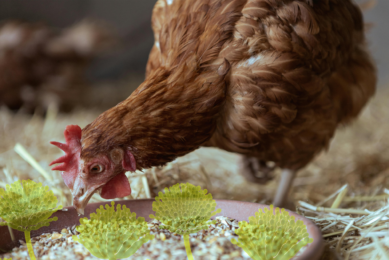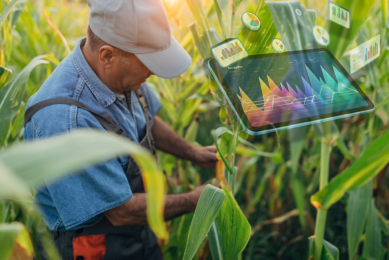Mycotoxins in pet food

Since cereal grains and nuts are some of the main ingredients in commercial pet food, it therefore follows that companion animals such as cats and dogs are frequently exposed to the effects of mycotoxins. This article will discuss the impact of major mycotoxins in companion animals and preventative strategies.
Mycotoxins are secondary fungal metabolites with low molecular weight, diverse chemical structures, and biological properties causing pathological changes in companion animals. They cause an annual loss of $5 billion in the United States and Canada due to their impact on human and companion animal health, and both domestic and international trade.
Aflatoxins
Aflatoxins are produced by Aspergillus parasiticus and Aspergillus flavus as common fungal contaminants of nuts. The naturally occurring forms of aflatoxin including B1, B2, G1, and G2 are hepatogenic and carcinogenic.
Affects: Aflatoxin in dog results in vomiting, depression, polydipsia, polyuria, hepatitis, anorexia, lethargy, jaundice, disseminated intravascular coagulation, and even death. Companion animals have various sensitivity to aflatoxin B1 with rabbits, mink, cats, dogs, and guinea pigs being more sensitive than mice or hamsters. Wild bird consuming corn, nuts, and seeds may suffer from aflatoxin intoxication, as well.
Ochratoxins
Ochratoxins are formed by numerous Aspergillus and Penicillium spp., including Aspergillus ochraceus and Penicillium verrucosum principally in cereal grains. There are 4 ochratoxin homologues: A, B, C, and D with ochratoxin A as the most prevalent, and ochratoxins A and C as the most toxic.
Affects: Ochratoxin A causes electrophilic attack on DNA, accumulates in kidneys due to high blood flow and tubular re-uptake, and interferes with signal transduction pathways in renal cells causing changes in renal function. Ochratoxin in dogs cause severe kidney damage, anorexia, vomiting, weight loss, tenesmus, intestinal haemorrhage, tonsillitis, dehydration, and prostration.
Fusarium mycotoxins
The Fusarium mycotoxins including trichothecenes, zearalenone, and fumonisins are a chemically and biologically diverse group of compounds particularly important in companion animal health worldwide. The trichothecenes including deoxynivalenol, diacetoxyscirpenol, and T-2 toxin are produced by Fusarium graminearum, Fusarium sporotrichioides, and Stachybotrys chartarum. Zearalenone is produced by Fusarium graminearum, Fusarium avenaceum, and Fusarium nivale, and fumonisin and fusaric acid are produced by a variety of Fusarium species. Cereal ingredients of pet food such as corn, wheat, and barley contain the Fusarium mycotoxins.
Affects:
Trichothecenes cause vomiting, feed refusal, gastrointestinal irritation, and immunosuppression in cats and dogs.
Zearalenone is an estrogenic mycotoxin producing pathological changes in the canine reproductive system.
Fumonisin causes liver and kidney cancer in rodents and fusaric acid causes reduced appetite, vomiting, suppressed weight gain, and hypotension in young dogs.
Tremorgenic mycotoxins
Tremorgenic mycotoxins are produced by Penicillium, Aspergillus, and Claviceps on meat, cereals, nuts, cheese, eggs, fruits, processed/refrigerated food during spoilage.
Affects: Most tremorgenic mycotoxins are neurotoxic indole alkaloids causing slight salivation, vomiting, ataxia, and muscle tremors in dogs.
Preventative strategies
Mycotoxins are chemically and thermally stable compounds; therefore, most preventative strategies focus on removing contamination early in processing without compromising nutritional quality.
There 3 major processing techniques to reduce mycotoxin content of cereals:
Sieving kernel: Reduces mycotoxins by 67-83% and washing methods remove mycotoxins primarily found on the outer surface of grains such as deoxynivalenol and zearalenone.
Washing: However, after washing the wet cereal grains need drying, causing an extra cost to feed manufacturers.
Pearling: Can be used to remove deoxynivalenol content of barley without wetting the cereal and physical dehulling procedure is used to reduce aflatoxin content of corn.
Prevention methods
The separation of cracked, damaged, and improperly developed kernels significantly reduce the mycotoxin content of cereal grains.
Ozonation is another detoxifying method to break down aflatoxin B1 and trichothecenes.
Acid-based mould inhibitors including benzoic, acetic, sorbic, and propionic acids are used to prevent mycotoxin formation in pet feed by acidifying the cytoplasmic content of fungal cells.
Furthermore, purchasing high-quality feedstuffs and proper handling of the grain to prevent kernel damage reduce mycotoxin formation.
In addition, application of microorganisms capable of detoxifying mycotoxins prior to absorption into nontoxic metabolites in pet food prevents mycotoxicosis. For instance, a strain of bacteria (BBSH 797) deactivates trichothecenes by reducing epoxide rings and Trichosporon mycotoxinovorans, a novel yeast strain, degrades ochratoxin A and zearalenone.
Concluding remarks
Mycotoxins have various pathological effects on companion animals causing health, welfare, and economic concerns. Further research is required to develop more efficient decontaminating processes to protect companion animals from the harmful effects of mycotoxins in pet foods.











